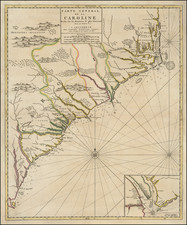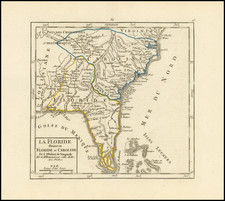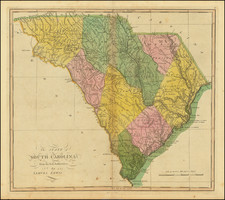The Earliest Obtainable View of Charleston.
Fine large format view of Charleston, based upon an iconic painting by Bishop Roberts in 1739, engraved by William Henry Toms, for the London Magazine, in 1762.
This view was the most widely circluated graphic image of Charleston prior to and during the American Revolution and was without question the means by which Europe came to visually know Charleston in the second half of the 18th century. As such, its historical importance cannot be understated.
There are two examples of the view. The second edition (1779) can be readily distinguished by the lack of the small sailing craft to the left of the flagged large sailing ship on the left side of first edition, just below the letter A.
The view affords one of the earliest graphic depictions of the town of Charleston. The view shows dwellings, churches, boats, fortifications and ships with British flags. Items in the image are lettered, but key is missing from image. Men in foreground hold fishing nets. At the time, Charleston was the fourth largest port in the American colonies, with a population of 11,000.
In the first half of the 18th Century, American cities were becoming significant commercial ports and thriving cultural centers. The desire on the part of the citizens to publicize their city and the interest among the English in colonial cities led to the production of several large perspective prints, including a large view of Charlestown issued in 1739, drawn by Bishop Roberts. The drawing was then sent to London, where it was engraved by W.H. Toms and offered for sale as a multisheet view.
The Bishop Roberts image shows Charlestown from across the Cooper River, extending from Granville Bastion to Craven's Bastion. The city is shown as a bustling port, the river filled with ships of all sizes, including some from the Royal Navy. The detail is impressive, with the buildings along the river quite easily identifiable.
A reduced version of the Roberts print was issued in the London Magazine in 1762. While considerably reduced, most of the detail is preserved and clearly recognizable in this fine engraving.
The view is quite rare on the market. We have handled the first state only 1 time in 25 years and this is the second time we have offered the second state over the same time frame.












![[Untitled Coast chart of North Carolina, South Carolina, Georgia, and Florida, with insets of the harbor of Charleston, S.C. and the entrance of the Saint Johns River]](https://storage.googleapis.com/raremaps/img/small/91737.jpg)

![[The First Maps Printed Color] Cartes en Couleur des Lieux Sujets aux tremblements de Terre Dans toutes les parties du Monde Selon le Sisteme de l’impulsion Solaire](https://storage.googleapis.com/raremaps/img/small/52293op.jpg)